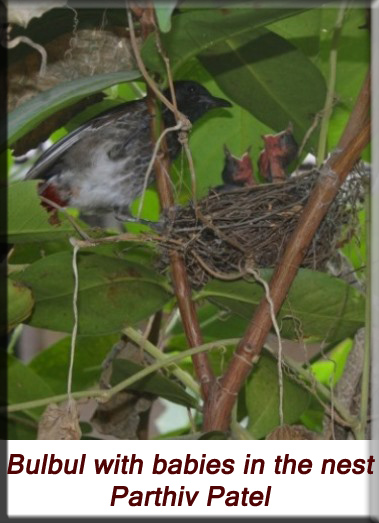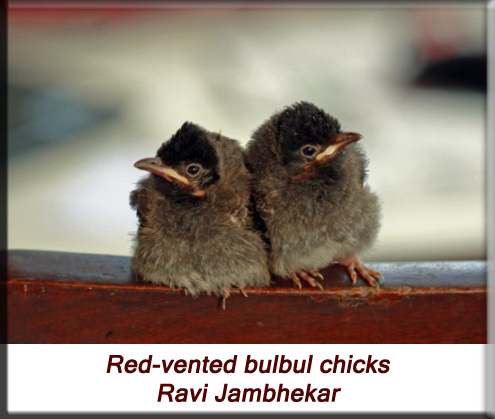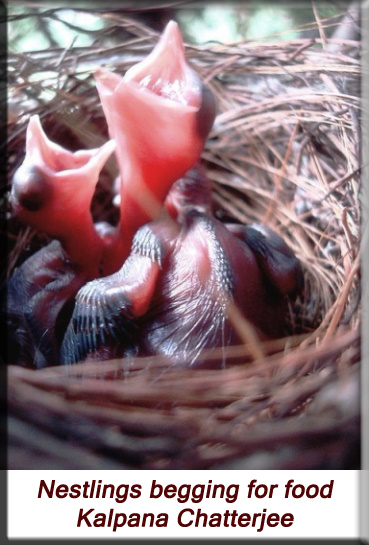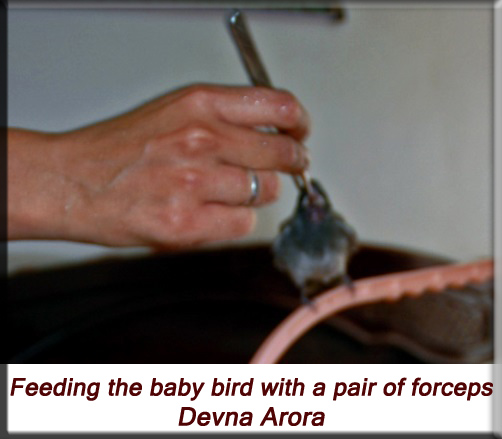Hand-rearing and rehabilitation of bulbuls: Red-vented and Red-whiskered bulbul
Ravi Jambhekar and Devna Arora
Bulbuls
Bulbuls are medium-sized passerine birds in the family Pycnonotidae that are widely distributed across Asia, Africa and South-Western Europe. Some of the highly adaptable and generalist species of bulbuls have spread extensively and can been seen in several other countries well beyond their native range. Bulbul species differ considerably in their habitat requirements with some preferring deep forests and thick undergrowth while others like the commonly found red-vented and red-whiskered bulbuls preferring forest fringes, scrublands, gardens, orchards and other rural and urban landscapes.
Both, the Red-vented bulbul (Pycnonotus cafer) and the Red-whiskered bulbul (Pycnonotus jocusus) are commonly found throughout India, although the red-vented bulbul, which is one of the most common birds of India, appears to be more numerous and extensively distributed.
Both species are extremely territorial although red-whiskered bulbuls are less aggressive in comparison. Although primarily frugivores, bulbuls are omnivorous birds that consume various invertebrates and (the urban species in particular) may even accept some grain.

Although bulbuls typically nest in the warmer months between February to September, it is not uncommon to find nests of red-vented bulbuls all year round. Both the red-vented and red-whiskered bulbuls make a cup-shaped nest in low shrubs, bushes or trees and readily nest in and around human habitations. The nest is primarily made of twigs, leaves, grass and moss and mostly built within a height of 7-10 feet off the ground. In fact, they have also been recorded nesting on the ground.
Need for assistance
Bulbuls are commonly rescued birds owing to their extensive distribution and proximity to humans. They are primarily admitted on account of the nest or nesting trees falling during heavy winds and storms. Such rescued babies may be placed in artificial nests and hung close to their original nesting trees – wicker or straw baskets or an open shoe-box will be ideal for the purpose. The basket must be large enough to accommodate the mother and the chicks. Observe the nest from a distance to make sure the parents have returned to the new nest and have started feeding the chicks. The parents are almost always there readily accepting the chicks and bulbuls have been reunited with great success.
The chicks are also commonly found during the fledgling stage when they either jump out of the nest too soon or land in unsafe locations. In most cases, the parents will be close-by, keeping an eye on the chicks and feeding them wherever they are, thus requiring no human intervention. Ensure, from a safe distance away so as not to scare away the parents, that the chicks have been unfed or unattended to for at least a few hours before attempting to rescue the chicks. The chicks must be hand-raised if the parents fail to return.
Chicks are also frequently rescued after unsuccessful predator attacks, typically by cats or crows. Such chicks are often in shock and may have extensive injuries. Healthy looking chicks must be placed back in their nest while those with injuries must be treated and returned to the nest at the earliest. It will be best for the bird to be with its own parents if it is in shock.
General guidelines for hand-rearing bulbuls

Hygiene
The chicks must be kept in extremely hygienic conditions until they are ready to fledge as young chicks are susceptible infections. Their bedding must be kept clean and changed as often as required. Hands must be washed every single time before touching the nestlings. Excessive handling of the chicks must be avoided and they must only be handled during feeding times, although in most cases, it will be absolutely unnecessary to touch the chicks even when feeding them.
Chicks will defecate several times through the day. Baby bird droppings are often enclosed in a capsule-like structure which makes it very easy for the parent birds to pick and drop them away from the nest. In most cases, you should be able to do the same and the paper towel lining may only be replaced a couple of times a day. But if you are unable to pick the droppings, then the towel must be replaced each time the chick defecates to prevent the droppings from sticking to the chick’s feathers and skin. Droppings harden after sticking to the body and are extremely painful to remove and inevitably peel off with a bit of skin, exposing raw skin to bacterial infections.
To remove any dried food particles or droppings that have stuck to the feathers or skin of the baby birds, wet the area with a drop of warm water and allow the particle to soak for a minute or two before attempting to remove it with your finger or with a piece of wet cloth. The procedure must be repeated if the particle doesn’t come out in the first wash.
Housing
The chicks must be housed indoors in small boxes or incubators. Smaller chicks may be kept in nesting cups to simulate the feel of the nest. A nesting cup is simply a bowl shaped bowl or basket covered with towels and tissue paper for the chicks. A 1-2 foot box will be adequate for the chicks. If using nesting cups, the cups may simply be placed inside the box.
The chicks must never be placed on the cloth towels directly as their nails tend to get caught in the fibrous loops of the towels. Cotton too must never be used to line the nests as it gets entangled around the chick’s beak and claws and also sticks to the droppings. The chicks must instead be placed on paper towels upon the cloth towel which also makes it easier to clean and replace soiled bedding.
On fledging, the chicks must be shifted to an aviary for adequate flight exercise before release. An aviary that is roughly 10 ft. X 10 ft. and 8-10 feet high is adequate for bulbul chicks. The aviary must be equipped with several perches and some foliage but must also allow the bulbuls to fly about freely and exercise their fight muscles.
Inter-species interactions
The chicks must never be house in close proximity to predatory species like crows, hawks, cats or dogs. Housing the chicks in close proximity to such species will either lead to constant stress due to the smells, sounds and movements of the predators; or it will lead to habituation and lack of fear and decrease their chances of survival after release.
Imprinting and dependency
Imprinting is a process whereby a young animal learns and imitates the behaviour traits of its parents. It serves as an indirect method of instilling the appropriate behaviour and survival traits in young animals.
Under the unnatural conditions of captivity, the chicks may imprint on humans and other animals they are constantly exposed to. To prevent this, they must never be handled excessively or exposed to too many people and animals, and handling must cease once the chicks have fledged. This also keeps them from being dependent on the caregivers.
Warmth
Birds, especially smaller sized birds, have higher basal metabolic rates and higher body temperatures ranging between 39˚C – 43˚C (102˚F – 107˚F). New-born chicks require additional warmth to maintain their body temperatures in the initial weeks of their lives and must always feel slightly warm on touch. As a rule of thumb, the smaller the chick, the more warmth it will require. Unfeathered chicks will require external heat all day long. The intensity of heat required will gradually reduce as the chicks become adequately feathered and discontinued upon fledging.
External heat may be provided in the form of incubators, heating lamps or hot-water bottles. Most breeding and rescue centres are equipped with incubators and prefer the same for baby birds. It is easiest to both control and monitor the temperature of the nest chamber when using incubators. But these may not be easily available to individual rescuers, in which case, alternate methods of providing external heat may be used. Baby birds found in the warmer months of the year will require little additional heat when kept at room temperatures but those found in the colder months of the year will require additional warmth throughout the day and will need to be monitored closely.
Heating lamps adequately serve the purpose of providing heat for nestlings. The distance of the heating lamp from the box will depend upon the local weather conditions, the wattage of the bulb and the body condition of the chicks. A room thermometer placed in the box will help you gauge the temperature and adjust the distance of lamp as and when required. Chicks that get too warm will pant to decrease their body temperature. If such behaviour is noticed, external heat must be reduced and ventilation increased immediately to prevent over-heating. The box must be covered with a cloth at night to prevent the light of the lamp from falling directly on the chicks and interrupting the natural circadian rhythm of the chicks.
Hot-water bottles may also be used for the chicks and are safe to use with smaller birds. The bottle, wrapped in a couple of layers of cloth, must be placed under the chick’s bedding and you must ensure that the chicks cannot come in direct contact with the bottle as they will scald if they do. Hot-water bottles must only be placed under half of the chick’s bedding leaving them the flexibility to shift to the uncovered part of the box if they get too warm. Hot-water bottles may even be placed just outside the box while still touching the box to ensure adequate warmth.
Water and hydration
Baby birds are seldom given water orally. They receive adequate water through their feeds. Baby birds must be offered soft and moist foods as it both assists digestion and ensures sufficient hydration. Mild dehydration may be addressed by offering the chick softer foods or formulas until dehydration has been addressed. To help restore the electrolyte balance in dehydrated chicks, rehydration electrolytes may be added to the formula. Refrain from administering water orally as the risk of water going down the trachea and aspirating the chick is high. If severe dehydration exists, the chick may be given fluids subcutaneously but this must only be done by an avian veterinarian. Severely dehydrated chicks must only be fed after dehydration has been addressed.
Baby birds that are dehydrated will appear weak and listless. Their skin, especially around the breast and stomach, will appear tighter and wrinkled. The skin turgor test or the ‘tent test’ may also be used to assess dehydration in naked hatchlings. Well hydrated chicks, on the other hand, are soft to touch and appear rounded and well. They will also be a lot more active and interested in movements around them than are dehydrated chicks.
Feed and formulas
The chicks need to be fed every half hour for the first two weeks of their life, and then every hour to every hour and a half until they fledge. Feeding must begin at dawn and continue for the next 12 hours or so until sunset. If feeding several chicks, you must ensure that all chicks are well fed as the runts or weaker chicks often get pushed aside and may consequently get weaker if not given adequate attention.
Baby bulbuls can be hand-raised on soft fruits and infant cereals. Protein must be provided in the form of boiled eggs or any of the green caterpillars or grasshoppers. Refrain from using hairy moth caterpillars as they can cause intense discomfort and damage to the baby. Baby bird hand-raising formula, where available, too may be used for baby birds. Different feed combinations will be appropriate for the chicks at different stages of their growth and development – details given in ‘stage-wise care’ after page 14.
Avian vitamins and calcium supplements must be added to the formula for baby birds. The next best choice to avian supplements (if none available) would be other veterinary or paediatric vitamin drops – choose a supplement with added minerals too. Most multivitamin combinations do not include calcium and this must be supplemented as well – veterinary calcium drops are a good option. Probiotics too may be added to the chick’s diet. Avian probiotics are of course the first choice but human or veterinary probiotics, for example, Gutwell, too will be helpful. The exact doses may be obtained from an avian veterinarian.
Baby birds are given a formula pureed fruit, infant cereals and boiled eggs. It is easiest to feed them with a syringe for the first 2-3 weeks of their life. Caterpillars may be introduced in small pieces initially. Once the birds are nearing fledging age, they can be fed small boluses of mashed fruit and egg either by hand or with a pair of forceps. Fledglings will comfortably takes pieces of fruit with a pair of forceps and will soon pick up pieces of fruit from a plate.
The consistency of the formula should be similar to that of a soft pudding – neither too thick, which would make it difficult for the baby to swallow and it may choke, nor too diluted as the baby could inhale the formula into its lungs causing aspiration. The chicks must be fed warm formula just as mammalian young are given warm milk. Formula that is too hot will scald the baby bird’s crop, causing crop burn, which is the scalding of the chick’s crop and oesophagus. Cold formula, on the other hand, will slow the process of digestion and cause ‘sour crop’. Sour crop is a condition in which the formula in the chick’s crop has gone bad as the contents of the crop have not emptied.
Once the chicks have fledged, fruit pieces must be offered at room temperature. Refrain from offering refrigerated fruits, rather, let the fruit come up to room temperature for an hour before offering it to the chicks.
Feeders
Feeding syringes are required for feeding formulas as baby formulas are much too soft to be picked up with the forceps or by hand. Syringes however must either be discarded or sterilized after every use. I prefer using a fresh 1 ml tuberculin syringe for each of the feeds. The 1 ml syringes are difficult to sterilize in water as the plastic is too soft and loses shape and is best discarded after every feed.
Bigger syringes (2 ml onwards) can be sterilized. However, I find them impracticable for thick feeds – they are okay for mammal milk formulas. The syringes must be rinsed to wash off any feed residue and then boiled in boiling water for 5 minutes to sterilize it. Not sterilizing the feeders will lead to a build-up of bacteria in the feeders which can prove to be fatal for the chicks.
A pair of blunt-tipped forceps is ideal for feeding fledgling bulbuls. These are easy to use, comfortable for the chicks and easy to clean. They only need to be washed with soap and water after the feed.
Feeding instructions
The chick can be placed on a napkin or paper towel on a table so you can feed the chick in a comfortable position – this is vital when feeding the chicks with a syringe. You can also feed the chick when it’s in the basket but all spilled food must be picked up immediately, often necessitating the bedding to be changed after feeds.

The chicks gape as soon as the feeder approaches them. If not, you may gently tap on the chick’s beak to stimulate begging and feeding. The chicks will only have a couple of morsels at a time. If using a syringe, feed the chicks the equivalent of a couple of bite-sized morsels for that chick. The chick must be given time to swallow the first morsel before the second one is offered. Once it has had enough to eat, the chick will stop gaping and refuse to open its beak. Feeding must be stopped immediately. The baby must not be forced to feed when it is reluctant to accept food. Force feeding or over feeding can cause the formula to flow into the throat and down its windpipe, which can be life threatening. The beak and feathers must be wiped gently with a moist cloth after feeding.

Baby bird droppings
Baby bird droppings are enclosed in a capsule which makes it easier for the parent birds to lift and throw out of the nest. The dropping will of course vary in colour and consistency depending upon the feed given, but should always be well-formed.
Bathing
Bulbuls love to bathe and play in water, particularly in the summers. Always have a shallow bowl of water for the birds (after they have fledged) to play in.
Sexing bulbuls
Male and female bulbuls are monomorphic, i.e., there is no external distinguishing factor between the male and the female.
Continue to Page 2: growth and corresponding care
Please note: This document is targeted at hand-rearing alone and does not address or substitute any veterinary procedures. For any medical concerns, please consult your veterinarian at the earliest.
For amateurs or people handling new born chicks for the very first time, please keep in touch with a trained and experienced hand for guidance and regular progress updates.
Protocol published in 2013





